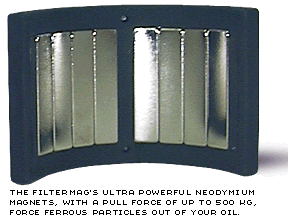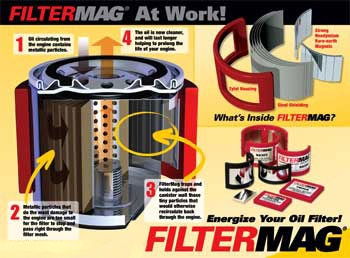|
 |
| i |
| FilterMAG™ Technology |
| i |
|
Oil Filter History
FilterMAG™ Magnetic Oil Filter System
Visual Proof
Oil Analysis Test
Warranty |
|
>>'Click' Here << to Buy Now |
Oil Filter History
 Modern oil filters remove particles by forcing the oil through paper-based media with very small ports. The technology behind this filtering media is a compromise that has remained relatively unchanged since the 1930s. While oil is necessary to remove these damaging particles, it is equally important that it flows back into the engine fast enough to lubricate all the moving parts. Modern oil filters remove particles by forcing the oil through paper-based media with very small ports. The technology behind this filtering media is a compromise that has remained relatively unchanged since the 1930s. While oil is necessary to remove these damaging particles, it is equally important that it flows back into the engine fast enough to lubricate all the moving parts.
A perfect oil filter media would stop all the particles down to 1-micron (about 1/70th the thickness of a human hair). Unfortunately, a filter with ports that small would also restrict the oil from returning to the engine fast enough, resulting in catastrophic equipment failure.
Filter media developments over the years have certainly increased the life cycle for oil filtration cartridges, but fluid dynamics require the ports in the media to remain 25-micron or larger.
An SAE report by David R. Staley, General Motors Corp., states:
"The smallest particles most popular filters captured with high efficiency are sized 25 to 40-micron, depending on the filter brand...[however] controlling the abrasive contaminants in the range of 2 to 22-micron in the lube oil is necessary for controlling engine wear."
These tests also confirmed that removal of particles down to 2-micron in size virtually stops the abrasion wear cycle. |
|
back to top |
| i |
FilterMAG™ Magnetic Oil Filter System
Patented FilterMAG™ Oil Filter Magnet Technology Removes Steel Particles As Small As 2-Microns from Engine Oil.
 In order for FilterMAG™ to remove minute steel particles from the oil system, its magnets must have enough energy to hold incredibly fine particles against the velocity of the oil flow. FilterMAG™'s patented design employs a focused magnetic force field, that amplifies its incredibly powerful Neodymium magnets, to generate the immense force needed to forcibly remove tiny particles below 20-micron from the oil flow; and retain increasingly smaller particles -- as small as 2-microns -- against the pressure of oil flow velocity. In order for FilterMAG™ to remove minute steel particles from the oil system, its magnets must have enough energy to hold incredibly fine particles against the velocity of the oil flow. FilterMAG™'s patented design employs a focused magnetic force field, that amplifies its incredibly powerful Neodymium magnets, to generate the immense force needed to forcibly remove tiny particles below 20-micron from the oil flow; and retain increasingly smaller particles -- as small as 2-microns -- against the pressure of oil flow velocity.
FilterMAG™'s patented magnetic flux amplifier technology redirects the magnetic energy normally present on the far side of the magnet towards the inside of the filter canister. The flux amplifier has to be of a precise thickness to maximize the magnetic field. The circumference is adjusted to allow for manufacturing variances to result in a precise fit & alignment of the series of magnets to the filter canister. This focuses the maximum amount of magnetic energy within the oil flow. The successful and proven result is a masterpiece of automotive engineering.
In real life, FilterMAG™ works by simply placing it onto the outside of the filter housing where the magnetic force automatically snaps it into place. The ultra strong magnetic force starts to work — forcibly trapping unwanted particles "locked" against the inside walls of your traditional filter. |
|
back to top |
| i |
Oil Analysis Test
Attached is a series of tests on one report. Predictive Maintenance Services performed the independent tests. The oil samples were taken on a 2002 Chevy with a Diesel Engine that has a Harvard Bypass System.
Test # 88532, 88069, 79299 was WITHOUT a FilterMAG™ placed on the filter. Test #95049 was performed WITH the FilterMAG™ in place on the filter.
While the spectro Fe (iron) stayed essentially the same, if you look at the graphic in the center you will see a huge drop in the particle count (350 on test #88532, only 58 on #95049). The symbol >2 and >5 refer to particle sizes, 2 micron and 5 micron respectively.
The date of each test is in the second column of the upper graphic. |
| i |
| Read the Report |
|
back to top |
|
|
|
|
|